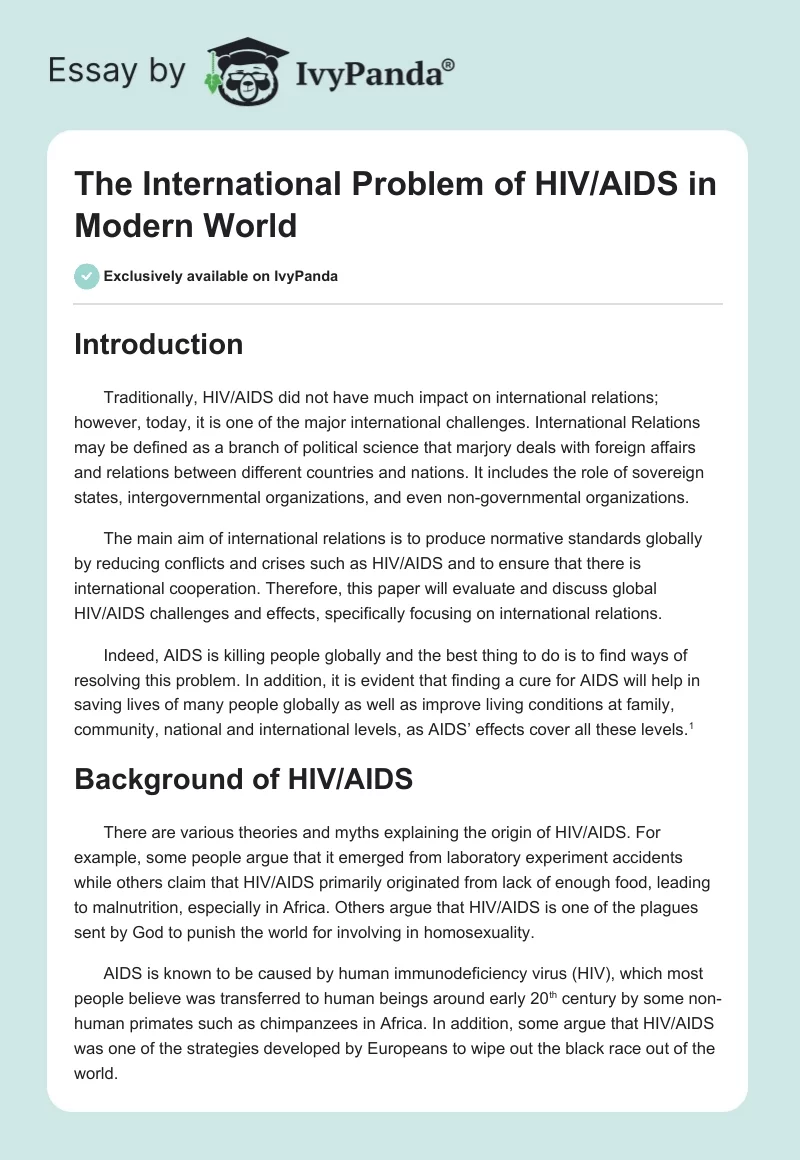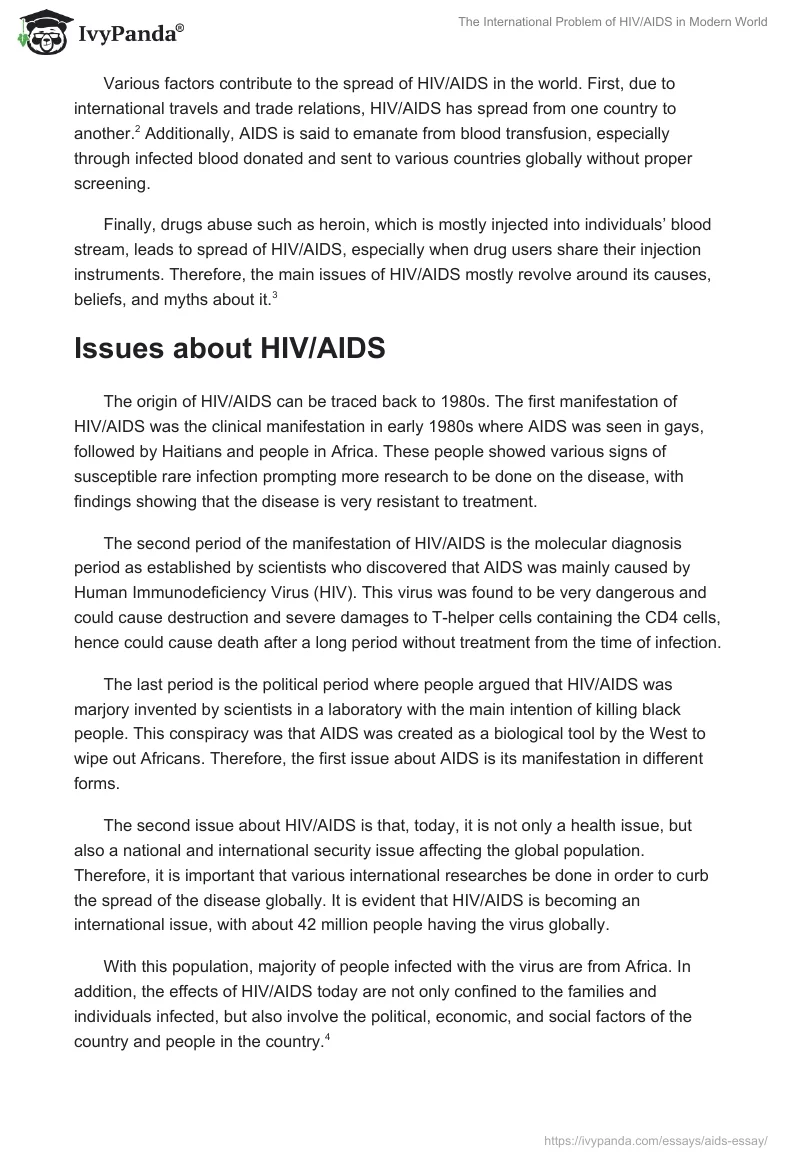Introduction
Traditionally, HIV/AIDS did not have much impact on international relations; however, today, it is one of the major international challenges. International Relations may be defined as a branch of political science that majorly deals with foreign affairs and relations between different countries and nations. It includes the role of sovereign states, intergovernmental organizations, and even non-governmental organizations.
The main aim of international relations is to produce normative standards globally by reducing conflicts and crises such as HIV/AIDS and to ensure that there is international cooperation. Therefore, this paper will evaluate and discuss global HIV/AIDS challenges and effects, specifically focusing on international relations.
Indeed, AIDS is killing people globally and the best thing to do is to find ways of resolving this problem. In addition, it is evident that finding a cure for AIDS will help in saving lives of many people globally as well as improve living conditions at family, community, national and international levels, as AIDS’ effects cover all these levels.
Background of HIV/AIDS
There are various theories and myths explaining the origin of HIV/AIDS. For example, some people argue that it emerged from laboratory experiment accidents while others claim that HIV/AIDS primarily originated from lack of enough food, leading to malnutrition, especially in Africa. Others argue that HIV/AIDS is one of the plagues sent by God to punish the world for involving in homosexuality.
AIDS is known to be caused by human immunodeficiency virus (HIV), which most people believe was transferred to human beings around early 20th century by some non-human primates such as chimpanzees in Africa. In addition, some argue that HIV/AIDS was one of the strategies developed by Europeans to wipe out the black race out of the world.
Various factors contribute to the spread of HIV/AIDS in the world. First, due to international travels and trade relations, HIV/AIDS has spread from one country to another. Additionally, AIDS is said to emanate from blood transfusion, especially through infected blood donated and sent to various countries globally without proper screening.
Finally, drugs abuse such as heroin, which is mostly injected into individuals’ blood stream, leads to spread of HIV/AIDS, especially when drug users share their injection instruments. Therefore, the main issues of HIV/AIDS mostly revolve around its causes, beliefs, and myths about it.
Issues about HIV/AIDS
The origin of HIV/AIDS can be traced back to 1980s. The first manifestation of HIV/AIDS was the clinical manifestation in early 1980s where AIDS was seen in gays, followed by Haitians and people in Africa. These people showed various signs of susceptible rare infection prompting more research to be done on the disease, with findings showing that the disease is very resistant to treatment.
The second period of the manifestation of HIV/AIDS is the molecular diagnosis period as established by scientists who discovered that AIDS was mainly caused by Human Immunodeficiency Virus (HIV). This virus was found to be very dangerous and could cause destruction and severe damages to T-helper cells containing the CD4 cells, hence could cause death after a long period without treatment from the time of infection.
The last period is the political period where people argued that HIV/AIDS was invented by scientists in a laboratory with the main intention of killing black people. This conspiracy was that AIDS was created as a biological tool by the West to wipe out Africans. Therefore, the first issue about AIDS is its manifestation in different forms.
The second issue about HIV/AIDS is that, today, it is not only a health issue, but also a national and international security issue affecting the global population. Therefore, it is important that various international researches be done in order to curb the spread of the disease globally. It is evident that HIV/AIDS is becoming an international issue, with about 42 million people having the virus globally.
With this population, majority of people infected with the virus are from Africa. In addition, the effects of HIV/AIDS today are not only confined to the families and individuals infected, but also involve the political, economic, and social factors of the country and people in the country.
Today, according to the World Health Organization (WHO), incidences of HIV/AIDS vary from country to country, with some countries having about 10% while others have around 90% prevalence of the disease. Lastly, the spread of HIV/AIDS at a faster rate globally is another issue. For example, the epidemic has been spreading globally since its discovery, with over 25 million people having died from HIV/AIDS, majority of them being adults.
Again, the effects of the disease have been seen in various countries, with increased poverty and poor economic growth rate incidences due to the pandemic noted. In the past, it was believed that HIV/AIDS mainly affected Africans, but contrary to that, today, the disease is seen to be affecting a significant number of people of all ages and races globally.
In addition, epidemiological data shows that HIV/AIDS is spreading much quickly in larger Asia, India, Caribbean, and even Eastern Europe. Although there are some significant effects of the disease globally, it is evident that the most seriously affected countries are in Africa, specifically the Sub-Saharan region. Therefore, the main issues in HIV/AIDS are about how to get its cure, how to convince the world about the realities of AIDS, and how to get the best effective prevention methods, since AIDS has no cure.
Complicated Issues
There are three major complicated issues about HIV/AIDS. To begin with, although scientists have attempted to find the cure of AIDS, they have been unsuccessful. Secondly, AIDS is a condition that makes the body susceptible to other diseases; hence, it is usually accompanied by other infections. The final complicating issue about HIV/AIDS involves myths and beliefs that people have towards AIDS globally.
For example, a belief such as AIDS is a curse and punishment from God sometimes makes it very difficult to find the best cure about the disease. Therefore, these complicating issues make it very difficult to get the most effective possible solutions towards the disease.
Possible solutions and Recommendations
National and international policy makers need to put in place measures that would help in curbing the disease, among them being education and training, especially in Africa where the disease poses serious challenges. Secondly, there is need of empowering Africans in order for them to adopt healthy lifestyle and high living standards that would allow them to prevent the disease.
Furthermore, global leaders should be involved in various HIVAIDS educational programs as well as encouragement for HIV/AIDS testing and counseling. Lastly, male circumcision programs should be encouraged to reduce incidences of HIV/AIDS in some African communities. Nevertheless, everyone infected or affected directly or indirectly should be in the forefront to implement the zero tolerance agenda to the fullest.
Various models and theories can also be used in order to prevent the spread of HIV/AIDS. Generally, theories are usually used to explain why people do what they do while models explain how they go about doing it. To begin with, AIDS risk reduction model explains how people adopt and change HIV related behaviors through risk assessment, enactment, and commitment.
Again, there is the diffusion of innovation theory, which explains how HIV/AIDS can spread through a population globally, for example through world opinion leaders. Besides, there is the ecological system theory that provides that HIV/AIDS spreads through families, communities, and even in various institutions.
In addition, there is the social capital and social cognitive theories, which explain that people usually get and spread HIV/AIDS through observation of others behaviors, social norms and beliefs. Therefore, these theories and models can be adopted in order to prevent HIV/AIDS spreading in the world.
Summary and Conclusion
It is clear that HIV/AIDS is an international problem that poses challenges to international relations among countries. In addition, it affects the economic, social, and political welfare of different countries. Furthermore, HIV/AIDS is one of the diseases in the world that do not have a specific treatment and cure.
Therefore, it is important for international policy makers to provide measures and means that would reduce the infection rate of the HIV/AIDS pandemic. This would result into improved economic development globally, leading to sound international relations among nations in the world. Nevertheless, all nations should focus on zero tolerance agenda aimed at eradicating new infections, deaths from HIV/AIDS related infections and stigmatization.
Bibliography
Bell, Sigall et al. AIDS. Santa Barbara: Greenwood, 2011.
Haacker, Markus. “Framing AIDS as an Economic Development Challenge.” Brown Journal of World Affairs 17, no. 2 (2011): 65-76.
Lule, Elizabeth & Markus Haacker. The Fiscal Dimension of HIV/AIDS in Botswana, South Africa, Swaziland, and Uganda. Herndon, VA: World Bank Publications, 2011.
Unknown. AVERT. 2013. Web.
United Nations. The Impact of AIDS. New York: United Nations, 2004.


